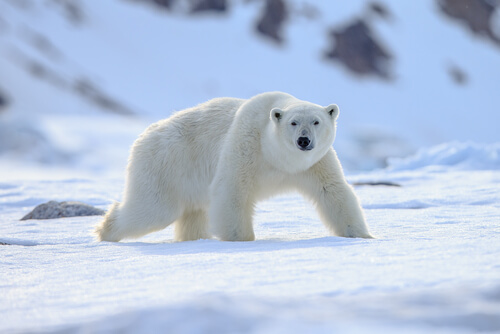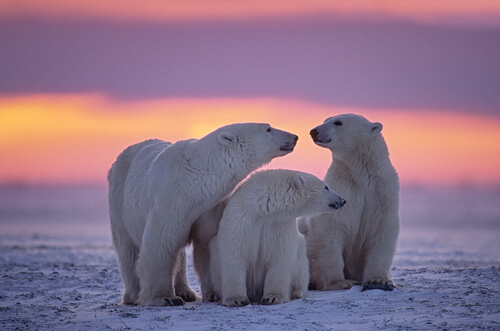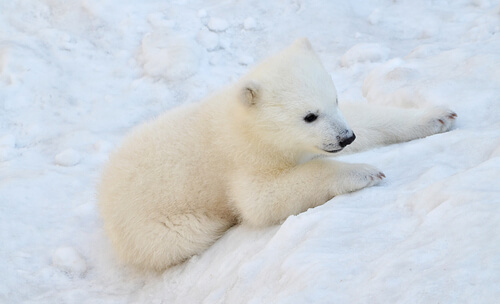
| Kingdom | Animalia |
| Phylum | Chordata |
| Class | Mammalia |
| Order | Carnivora |
| Family | Ursidae |
| Genus | Ursus |
| Species | Ursus maritimus |
| Niche | Apex Predator |
| Length | 5.9-9.8 ft (1.8-3 m) nose to tail |
| Weight | 330-1600 lb (150-450 kg) |
| Lifespan | 20-30 years |
| Social Structure | Mostly solitary outside breeding season |
| Conservation Status | Vulnerable |
| Preferred Habitat | Arctic Sea Ice |
| Average Litter Size | 1-4 cubs |
| Main Prey Species and Food Items | Seals, walruses |
| Predators | Humans |
The Basics
The polar bear is a large predatory bear species native to the Arctic regions. It is also known as the white bear, the ice bear, or the sea bear, and spends most of its time traveling on sea ice in search of prey such as seals.

Description
The polar bear is massive and has a stocky build with a striking white or cream-colored coat and a long neck and snout in comparison to most other bear species. It has large paws that help it to walk efficiently in its snowy environment. These are also effective as paddles when the polar bear is in the water swimming between sections of sea ice. Polar bears also have small ears and short tails.
At nearly 10 feet long and weighing about 1,600 pounds, the polar bear is likely the largest species of bear in the world, challenged only by the Kodiak Bear, a subspecies of the grizzly bear. Males are significantly larger than females, which normally way no more than 1,000 pounds.
Distribution and Habitat
Polar bears are found in the Arctic regions of the world. Most of the time they are traveling on sea ice. During the summer months, they may find their way to terrestrial sub-Arctic Tundra habitats. As they regularly hunt marine mammals such as the ringed seal, polar bears prefer sea ice that is prone to fracturing and splitting, which allows them more potential access to their prey as it comes up for air.

Diet and Predators
Polar bears are carnivorous, apex predators. In order to stay warm in their Arctic environments and to survive their long winter hibernations, polar bears need to maintain a fat layer of up to four inches thick. They rely mostly on various species of seals for subsistence. They will often wait near the seal’s air hole or the edge of a sheet of ice, attempting to pounce on the unsuspecting seal as they attempt to catch a breath.
Polar bears will also hunt walruses, although it is a much more risky endeavor due to their size and large rusks they can use to defend themselves. They will usually approach a group of walruses that have hauled out on the sea ice, attempting to surprise them and pick off a young or injured individual if possible. In some cases, polar bears have been known to hunt other marine animals such as beluga whales. They are also opportunistic and exhibit scavenging behaviors at times, consuming dead fish or the carcasses of beached whales, for example.
Although a seal or small walrus can provide enough direct sustenance for an adult polar bear to remain satiated for up to eight days, they must eat much more frequently to maintain this layer of fat.
As an apex predator, the polar bear itself has virtually no natural predators. Due to the relative remoteness of its Arctic habitat, most polar bears have had little interaction with humans and thus have not learned to avoid them in the way most other bear species have. In combination with their sheer size and power, this makes the polar bear a very dangerous animal for humans to be in the presence of. Polar bears are sometimes hunted in small numbers by Inuit peoples.
Reproduction
Polar bear breeding season beings during the spring. Following copulation, females often delay implantation of the fertilized ovum. Including this delay, the gestation period lasts for about 6-9 months, with litters of one to four cubs normally being born in the den the following winter. At birth, polar bear cubs weigh about two pounds and will begin nursing in the den immediately while they and the female remain in their den through the winter.
The following spring, the family will emerge from their dens. Cubs are particularly vulnerable to predation, especially by adult males of their own species. Therefore, they will stay very close to their mom throughout their first summer, hibernating again with her the following winter. Cubs are not weaned until they are about two years old. During this time, females are particularly aggressive as they are fiercely defensive of their young. Young will normally remain with their mothers for another two years, usually becoming independent when they reach sexual maturity at about four years old.
Females will normally reproduce every two to four years throughout her lifetime, with the success of each litter playing a determining role in that timing. If her cubs don’t survive their first few years, she will become pregnant again. However, while she continues to nurse and care for her juvenile cubs, she will normally delay breeding until their 3rd or 4th year to avoid having new cubs while her previous litter is still dependent on her. In the wild, most individuals don’t live past about 25 years of age while in captivity some polar bears have lived to be more than 35 years of age.
Conservation Status
Although adult polar bears face little threat of natural predation by other animals, many deaths are caused by humans. Inuit people will hunt polar bears for sustenance. Others are killed as ‘problem bears’ where they have invaded human settlements and towns, which can be avoided by limiting bear attractants such as garbage and other waste.
In addition to these direct threats from humans, polar bears have long been held up as a victim of global climate change. As global surface water temperatures rise, sea ice is further diminished. This effectively restricts the polar bear’s access to important hunting grounds, forcing them to swim more, using up important energy stores further in the process.
In combination with the polar bear’s generally slow reproduction rate, these factors all spell an uncertain future for the species. Indeed, their populations are in decline globally and, currently, the polar bear is listed as Vulnerable on the IUCN Red List of Threatened Species.
Fun Facts about the Polar Bear!
Polar bears are a fascinating species not only for their size and elusiveness but also for the many fun facts and interesting biological concepts that they allow us to explore.
A Marine Mammal that Walks
When most people think of marine mammals, they generally think of species such as dolphins, whales, seals, and sea lions. Perhaps a little less obvious might be other species like the sea otters which have paws rather than flippers. In fact, along with the sea otter and the coastal wolves of British Columbia, the polar bear may be one of the only species of marine mammal that doesn’t have fins.
This distinction is clearly made more for their behavior than their morphology. Apart from a small part of each year when the sea ice retreats and the polar bear travels to its summer breeding grounds in the sub-Arctic tundra, it will spend most of its time on sea ice or swimming in the Arctic ocean. Because of this, it was determined that the polar bear is indeed a marine mammal, making it the only type of bear to receive this designation.
A Natural Solar Heater
The polar bear’s Arctic environment leaves it in constant search of ways to keep itself warm. In addition to the maintenance of a thick layer of fat under its skin, it also has black skin covered by a white coat. This fur allows for the passage of sunlight, allowing for the heat to be absorbed by the darker skin underneath. This can help to warm the animal when sunlight is available and can reduce the burden of constantly hunting to stay warm.

Built for the North
The polar bear has very large paws of up to 12 inches wide. These allow them to swim effectively, uniquely using only their forepaws to paddle. In addition, they act much as snowshoes do for humans, increasing their surface area and allowing them to move through snowy environments more easily. Thanks largely to this adaptation, the polar bear is quite adept at moving on land and sea ice as well as in the water. In fact, it is a particularly fast predator for its size and is capable of reaching a top speed of about 25 miles per hour when running.
The polar bear has many other adaptations that help it to thrive in its extreme environment. These include its extra eyelids that protect their eyes from the cold and heavily padded paws on its underside that provide excellent traction on the often slippery sea ice. Along with their long, sharp claws, these pads also provide gripping ability when they are hunting and eating.
Collectively, these adaptations make the polar bear a tragic demonstration of how species that have evolved for tens of thousands of generations to thrive in their environments are often unable to adapt quickly enough to survive the rapid changes to many global ecosystems that have been brought about by anthropogenic global climate change.
